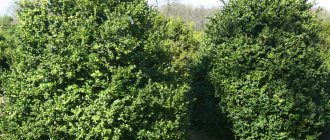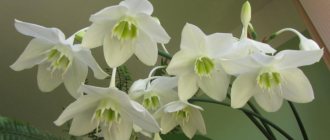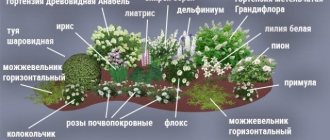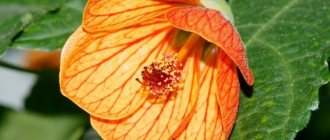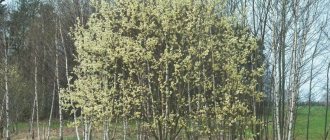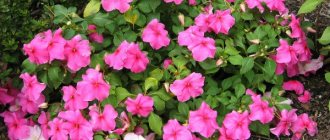The name of this group of plants speaks for itself: they live for one summer. Their development - from sowing in spring to the formation of new seeds in autumn - lasts one growing season. But over their short life, they become a bright decoration of a personal plot and give flower growers a lot of positive emotions. Counters of specialized stores and Internet catalogs offer a huge assortment of different types and varieties of flower and ornamental crops. How to choose annual flowers for a flower bed depending on their height, structure, placement method, when and how to plant - we will tell you in detail in the article.
Bright “suns” in the flowerbed: marigolds and zinnias
Annual plants are divided into true annuals and conditional ones, which by nature are perennial, but are grown in culture as annuals. These are petunia, snapdragon, fragrant tobacco, etc.
Classification of annuals
In order to choose the right annuals for your flowerbed, you should become familiar with their types, biological characteristics and uses. The following groups are distinguished:
- decorative flowering;
- ground cover;
- curly;
- decorative deciduous;
- dried flowers;
- container
Let's look at each group in more detail.
Decorative flowering (beautifully flowering)
Tall species (1-2 m high), for example, caudate amaranth, three-month lavatera, cosmos, summer delphinium, cleome are used to create hedges, they camouflage fences, sheds, and are planted in the center or in the background of flower beds.
Amaranth caudate leaves and seeds are edible. It is an important food crop in India and South America; in temperate climates the seeds do not ripen
Medium (0.5-1 m high): asters, erect marigolds, zinnia, cornflower, snapdragon, lavatera, statice, eustoma. Medium-sized summer gardens occupy the center or next row of the flower garden. Many of them are very good for cutting, for example, eustoma (lisianthus, Irish rose), beloved by florists.
Eustoma is very capricious: it does not grow well, prefers diffused sunlight, needs supports
Low (25-50 cm): eschscholzia, petunia, calendula, asters, rejected marigolds, verbena, salvia. They are planted in the first, often the second row from the edge of the flower garden, in separate groups; many species are suitable for container gardening.
Verbena can decorate a summer cottage both as part of flower beds and in containers
Dwarf (10-20 cm): viola, alyssum, lobularia, ageratum. Dwarfs are planted in the foreground of flower beds, on hills and rockeries, in flowerpots, pots, and balcony boxes.
Viola is considered a biennial, but if you sow seeds for seedlings in January-February, the plant will delight you with flowers in the year of planting
Ground cover (carpet)
Low-growing, unpretentious plants (no more than 30 cm in height, mostly 10-20 cm), capable of growing quickly and filling space. They grow like a carpet over the soil surface.
Representatives: alyssum, lobelia, iberis, limnanthes, annual phlox, dwarf ageratum, ever-flowering begonia.
Purpose: foreground of flower beds, ridges, borders, filling voids between perennials, including conifers, alpine slides, rockeries.
Long-flowering Limnanthes Douglas gives good self-sowing and after a single sowing is able to please every year, ideal for rocky gardens and borders along paths
Curly
Fast-growing plants with long stems from 2 to 6 m. They cling to the support with the help of tendrils.
Representatives: decorative beans, purple morning glory, climbing kobe, large nasturtium, hybrid, Canarian.
Used for vertical gardening: designing hedges, garden gazebos, verandas, arches, camouflaging old buildings, fences.
Nasturtium Canarian (foreign) is amazing for its flowers and five-lobed leaf shape
Decorative foliage
Thanks to the unusual shapes and colors of the leaves, plants of this group have earned well-deserved recognition among landscape designers and amateur gardeners.
Representatives: amaranths, ornamental cabbage, coleus, kochia, cineraria, castor beans.
Use: borders, ridges, flower beds, mixborders, soliter (single) plantings.
Bright coleus, like elements of a colored mosaic, look especially advantageous in border plantings
Dried flowers
This group includes plants that retain their shape and color for a long time after cutting. Many of them have hard petals, a dry, scaly inflorescence wrapper, and a pubescent stem.
Representatives: helipterum, helichrysum, gomphrena, statice, amaranth, celosia, lunaria, xeranthemum.
Purpose: flower beds, mixborders, ridges, alpine slides; drawing up decorative compositions, winter bouquets.
The homeland of statice (kermek) is Central Asia, so the plant loves the sun, is adapted to poor soils, and does not respond well to waterlogging
Container (potted)
They are distinguished by their compactness, decorativeness, and the ability to constantly bloom throughout the season.
Representatives: petunia, calibrachoa, lobelia, bacopa, Drumond's phlox, allisum, nemesia, low-growing marigolds, dwarf snapdragon. They are planted in pots, flowerpots, boxes, hanging baskets.
Calibrachoa is the closest relative of petunia, strewn with many small (up to 3 cm in diameter) flowers with a yellow or brownish center
Container floriculture is popular not only among those with balconies. From several flowerpots you can create a mobile flowerbed and place it at the entrance to the house or gazebo, on the open terrace.
Nemesia is increasingly winning the hearts of flower growers who are fed up with the popular petunias and lobelias
Unfortunately, the size of the publication does not allow us to show all the photos of annual flowers for the flower bed. They can be easily found on the Internet.
Marigold
for marigolds (Tagetes) in a flower garden, border or mixed border They can also be planted in hanging boxes or containers. Marigolds can grow in any conditions, they are completely undemanding to the soil, and can safely tolerate replanting at any age, even during the flowering period.
Marigolds (Tagetes). © ChristophNRW
These flowers feel best in sunny areas, but can also tolerate light partial shade. When selecting a variety, you need to take into account that different types of tagetes (marigolds) differ in the shape and height of the bush.
Nowadays, three types of marigolds are most often found in garden plots:
- rejected, or French - highly branched bushes from 15 to 50 cm high with double or simple inflorescences;
- erect or African - bushes from 30 to 120 cm in height with a strong stem and a small number of branches; flowers are large, double, of different colors;
- thin-leaved or Mexican - plants with thin branched stems and heavily dissected leaves, 20-60 cm high; spherical bushes are completely strewn with small, non-double flowers of bright colors - lemon yellow, orange, yellow, plain or with a dark center.
Read more about marigolds in the article Marigolds in garden design.
Advantages of flower beds made from annual plants
Gardeners widely use flowering annuals to decorate their plots, as they:
- They delight with their beauty, brightness, richness of color palette of all possible shades, variety of shapes of single flowers and inflorescences.
- Capable of continuous flowering from June to October.
- They provide the opportunity for annual planning, updating, selection of new varieties and complete replacement of the composition of the flower garden.
- With the help of annuals, you can successfully develop virgin lands - before planting them, every year the soil is dug up, weeds are removed, and enriched. If you immediately plant perennials, such cultivation will be difficult.
- Undemanding in care.
The main difficulties arise, as a rule, during the cultivation of seedlings: some seeds may not hatch at all or may sprout in small quantities; plants sometimes die at home due to unregulated watering, bacterial, fungal infections, do not take root during transplantation, and suffer from street from returning frosts, which, it would seem, have already passed. But this does not stop avid flower growers. You can always sow or make a replacement by purchasing seeds of other varieties with a later sowing time.
Growing by seedlings allows for earlier flowering
For those who do not want to bother with seedlings at home or do not have suitable conditions (lack of wide window sills, lack of light, which, by the way, can be solved with the help of phytolamps (AliExpress offers the widest selection)), it is easy to buy ready-made seedlings, sow the seeds in a greenhouse or greenhouse, or even straight into the ground.
There are annuals that grow well only by sowing seeds into the soil in early spring or autumn. Such plants do not tolerate transplantation well due to the sensitivity of the root system.
Care instructions
In dry weather, timely watering is important, but water should not get on the buds. Watering is best done in the evening or in the morning. It is necessary to loosen the soil in a timely manner, remove weeds, remove wilted flowers, otherwise the flowerbed will look untidy. Feed the plants 3-5 times a season. The soil is mulched , this will help retain moisture at the roots and prevent the growth of weeds.
Annual ornamental plants will help create an excellent living garden, fill it with rich colors, and fit perfectly into many styles of landscape design.
Landing dates
The optimal timing is calculated depending on the region and method of cultivation. We summarize the recommendations for flower growers in central Russia in the table:
| Growing method | Boarding time | Representatives |
| Seedless | ||
| Early spring sowing | Second half of April | Mattiola, iberis, blue cornflower, eschscholzia, cosmos, calendula, clarkia |
| Late spring | First ten days of May | Marigolds, nasturtium, lavatera, malopa, morning glory, sweet pea, dimorphotheca, acroclinum |
| Podzimny | Late October – early November | Godetia, cornflower, calendula, cosmos, antirrinum (snapdragon), iberis, clarkia |
| Rassadny | ||
| Winter sowing | End of January – February | Evergreen begonia, verbena, lobelia, petunia, Chabot carnation, eustoma, annual delphinium, viola, statice |
| Early spring | March | Ageratum, alyssum, amaranth, asters, verbena, gatsania, Chinese carnation, heliotrope, helichrysum, sweet pea, kochia, gillyflower, lobelia, snapdragon, nemesia, perilla, petunia, salvia, sweet tobacco, Drummond's phlox, cineraria |
| Mid-spring | Mid April | Marigolds, zinnia, amaranth, dahlias, coleus, celosia, chrysanthemums |
In the northern regions, Siberia, and the Urals, sowing seeds for seedlings and, accordingly, planting in open ground are shifted to a later date
Gazania
This beautiful, spectacular flower, similar to a large bright daisy, has recently appeared in our gardens. Gazania , thanks to its unpretentiousness, very quickly won the love of gardeners.
Gazania. © Viv
Unlike zinnia, gazania is not at all afraid of frost. With the onset of autumn cold weather, it seems to gain a second wind, blooming more and more new inflorescences. This flower looks good in containers and single plantings. Gazania can also be planted on alpine hills, since it requires almost no watering or fertilizing.
The only condition that should not be neglected when growing gazania is the correct location. Its flowers open only in the daytime and only under good lighting conditions. Therefore, for planting gazania, it is recommended to choose sunny areas with loose, permeable soil.
Gazania is a perennial plant that is grown as an annual in our latitudes. It can be easily grown in seedlings, and it is not necessary to use lighting. The sooner you sow the seeds, the sooner you can admire its beautiful flowering. If desired, gazania bushes can be stored in a cool room until next spring, and then planted again in the flowerbed.
What other annuals, besides gazania, can be preserved until spring, read the material 12 annuals that can be preserved in winter.
Rules for placing plants in a flower bed
For joint planting, it is necessary to select crops belonging to a single ecological group with the same requirements for environmental factors. Light-loving - in a sunny place, shade-tolerant - in the shade. Most of the plants listed above are light-loving. Shade-tolerant plants include: begonia, balsam, mimulus, nemophila. Lobelia, petunia, marigolds, and nasturtium tolerate partial shade.
In an attempt to diversify your flower garden, it is not advisable to chase the number of varieties . For a small flowerbed, 2-3 types will be enough.
choice of color combinations plays an important role in creating a beautiful and harmonious composition . When planning, you can rely on the color wheel.
The following triads are commonly used: red-yellow-blue, orange-green-violet. Transitions from one color to another also look good, for example, yellow, light yellow, yellow-green, yellow-orange. It is better when the color intensity increases from the edges to the center of the flowerbed: light pink, pink, light red, red in the center
Flowers in neutral shades of white, gray, black (dark purple, maroon) are widely used in landscaping to soften contrasts.
Lilac petunia, purple verbena with a white eye and snow-white lobelia - simple, elegant, harmonious!
The height of the plants should decrease evenly towards the edges of the flower bed. Tall ones are placed in the center or in the background. Strong differences in levels should not be allowed. So, in discount gardens, the height of the tallest flowers should be from a quarter to half the width of the flower bed itself. In the foreground they create a small border of low-growing plants.
Tall flyers are planted less often than short ones. Low-growing species are better adapted and look more impressive in a dense planting. The manufacturer always indicates recommendations for placing plants and the distance between them on the back of the seed bag.
Iberis
Iberis , or Iberian, is a low, compact plant that blooms profusely almost all summer. In total, there are about 40 representatives of this genus, including both annual and perennial species. The homeland of various types of Iberis is considered to be the mountainous areas of southern Europe and Asia Minor, the mountain slopes of the Crimea, the Caucasus, as well as the lower reaches of the Don.
Iberis, or Iberian
This unpretentious plant is often used to decorate ridges and alpine slides. It can also be used to decorate rocky retaining walls and dry slopes.
Now in our gardens you can find two types of annual Iberis - bitter and umbelliferous. The height of plants usually does not exceed 30-35 cm. There are varieties with white, pink, lilac and carmine inflorescences. Annual Iberis bloom longer and more abundantly than perennial ones; their flowering lasts up to 1.5 months.
Read more about growing Iberis in the garden in the article Simple secrets of caring for Iberis.
Beauty and versatility: options for using annuals
In the garden, flower beds are often made consisting of annual plants of the same species, for example, marigolds.
The center of the border is occupied by thin-leaved marigolds, on the sides - low-growing upright
Marigolds (tagetes) in many countries are valued as a seasoning, a medicine, and are used on holidays and during religious ceremonies. Essential oils released by plants repel insect pests and kill pathogenic soil microflora, so they are recommended to be planted among vegetable crops.
It is better to select annual flowering and decorative deciduous flowers for the flowerbed. Their combinations allow you to create spectacular compositions.
A simple square flower garden with marigolds, silver cineraria and lobelia erinus bushes around the perimeter
An interesting option is a polygonal flower bed on the lawn.
White snapdragon in the center, then a row of purple petunias, alternating marigolds and cineraria around the perimeter
To create complex flowerbed compositions, you must first draw a plan on paper, and when planting seedlings in the ground, use markings: it is convenient to “draw” them using thread and pegs.
The background is created by summer dahlias, in - kochia; “petals” of lilac ageratum, white alyssum, marigold, with cineraria around the perimeter
Annuals are a real lifesaver for filling the voids between perennials in regular plantings. They can be used to decorate borders around the perimeter of buildings and along garden paths.
White alyssum copes with two tasks at once: it limits the flowerbed and emphasizes the beauty of the main accent - blue spruce and blooming roses
Designers love to create interesting compositions using stone, wood, household items and other available materials. Why not use their ideas at your dacha?
A blue scattering of lobelia, double petunias, marigolds and gatsanias in pots are combined into an original composition with elements of country house equipment
Caring for annual plants is easy. They require timely watering, weeding, fertilizing with ready-made mineral fertilizers, loosening, and removal of faded flowers and inflorescences. Some species (lobelia, petunia, alyssum) love pruning and respond to it with a new, long wave of flowering. Usually they are pruned in mid-summer, shortening the shoots by a third, or even more.
Vegetables
“Name the annual plants” - this task is often offered to schoolchildren or students by teachers of biology and ecology. Usually, annual vegetables are listed first: cucumber, tomato, sweet pepper, eggplant, zucchini. In addition to division based on the duration of the life cycle, there is also a classification according to the type of application of the product. Thus, in the group of annual fruit vegetables there are: tomatoes, cucumbers, zucchini, pumpkin, watermelon, melon; cauliflower and Chinese cabbage, lettuce, radishes, dill.
Basically, hybrids are now grown, which are distinguished by large fruit sizes, high taste, and good transportability. From the very beginning of the life cycle of such plants, they need to create optimal conditions in which the potential of the variety will be revealed.
With the onset of the growing season, plants must receive nutrients in full and the amount of moisture they need. Control of pests and diseases that destroy a significant part of the potential harvest must be organized. One of the effective methods is crop rotation, the absence of adjacent vegetables from the same botanical family, such as nightshade, in plantings.
Climbing annuals
Anyone who loves flowers knows how difficult it is to live without climbing plants. With the help of vines you can hide unsightly places that exist in every household.
These climbing plants can turn an ordinary fence into a green hedge. They will add a special charm to an ordinary dacha.
Here are blooming annual flowers that will become lush vines in your garden:
- Morning glory - this unpretentious flower can grow up to 3 meters in height;
- Sweet pea - it will not reach the same heights as morning glory, but its flowers will delight you from July until frost. In addition, its flowers do not fade under the most scorching rays;
- Nasturtium - yes, nasturtium can also be considered as a climbing vine of a very noble appearance;
- Kobeya is a very unusual and beautiful flower. However, you need to remember that it should be planted as seedlings.





